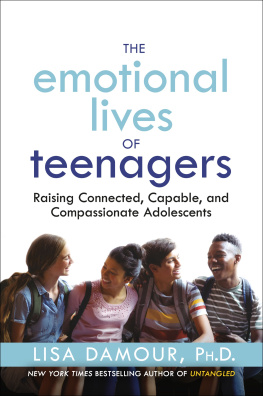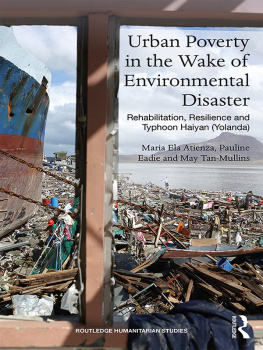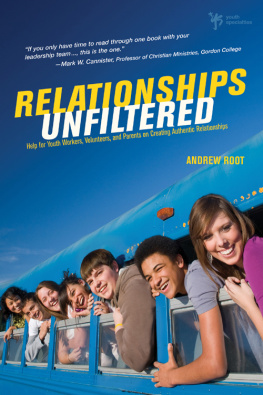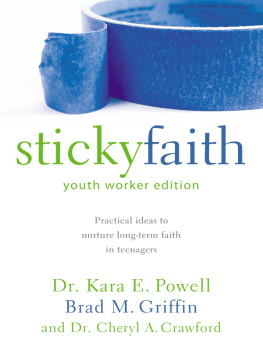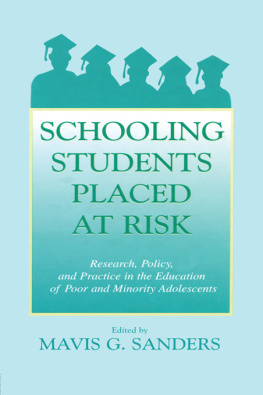Thank you for buying this ebook, published by NYU Press.
Sign up for our e-newsletters to receive information about forthcoming books, special discounts, and more!
Sign Up!
About NYU Press
A publisher of original scholarship since its founding in 1916, New York University Press Produces more than 100 new books each year, with a backlist of 3,000 titles in print. Working across the humanities and social sciences, NYU Press has award-winning lists in sociology, law, cultural and American studies, religion, American history, anthropology, politics, criminology, media and communication, literary studies, and psychology.
EVERYDAY COURAGE
QUALITATIVE STUDIES IN PSYCHOLOGY
GENERAL EDITORS
Michelle Fine and Jeanne Marecek
Everyday Courage:
The Lives and Stories of Urban Teenagers
by Niobe Way
EVERYDAY COURAGE
The Lives and Stories of Urban Teenagers
NIOBE WAY
NEW YORK UNIVERSITY PRESS
New York and London
1998 by New York University
All rights reserved
Library of Congress Cataloging-in-Publication Data
Way, Niobe, 1963
Everyday courage : the lives and stories of urban teenagers/
Niobe Way.
p. cm. (Qualitative studies in psychology)
Includes bibliographical references and index.
ISBN 0-8147-9320-7 (cloth : acid-free paper). ISBN
0-8147-9339-8 (pbk. : acid-free paper)
1. Urban youthUnited StatesCase studies. 2. Urban youth
United StatesLongitudinal studies. 3. Socially handicapped
teenagersUnited StatesCase studies. 4. Socially handicapped
teenagersUnited StatesLongitudinal studies. 5. Adolescence
United States. I. Title. II. Series.
HQ796.W325 1998
305.2350973091732dc21 97-45296
CIP
New York University Press books are printed on acid-free paper,
and their binding materials are chosen for strength and durability.
Manufactured in the United States of America
10 9 8 7 6 5
To Malcolm and Eva
Contents
Acknowledgments
First and foremost, I wish to express my gratitude to the adolescents who were willing to share their stories with me and my colleagues. Without their patience, cooperation, and wisdom, this book would not have been written. I am also grateful to the Henry Murray Research Center at Radcliffe College for financial support of this project.
My deepest appreciation extends to my graduate school mentor and friend Carol Gilligan, whose teachings are the inspiration for my research. Carols intellectual guidance and vision have provided me with the essential tools with which to pursue my own research questions. There have also been numerous friends, colleagues, former teachers, and students who have graciously read this book and provided me with constructive criticism, wonderful insights, and much encouragement. These people include Elizabeth Abrams, Charles Baraw, Elizabeth Chin, Michelle Fine, JoEllen Fisherkeller, Monica Garcia, Patricia Harmon, Stuart Hauser, Laura Maciuika, Allison Morell, Meg Turner, and Janie Ward. Charles Baraws extremely close reading of this book was especially helpful. I also want to extend a special thanks to Helena Stauber and Michael Nakkula for interviewing many of the adolescents and for their years of support and intellectual challenge. The project would not have been possible without them. Thank you as well to Jamie Aronson and Stacy Scott for helping to conduct the interviews, to Madeline Alers for taking the photos that grace the cover of this book, and to Annie Rogers whose remarkable work on ordinary courage among girls was the inspiration for the title of this book and for the substance of some of the chapters.
Tim Bartlett, my editor at New York University Press, made astute suggestions and was consistently enthusiastic. I thank him for both. I also thank Kelly Washburn for helping me put the manuscript together and for doing an excellent job of editing it page by page.
I am also grateful to my mother, father, and stepfather (Brenda, Peter, and Henry) for their keen observations on this project and for raising me to be a critical thinker and a believer in social justice. My mothers editorial feedback, in particular, has greatly influenced the form and content of this book. Thank you mom!
And, finally, I wish to thank my husband Ulrich, who has not only been a tremendous source of support throughout the many years of this project, but who has also provided constant, thorough, and important feedback at each and every step of the process. His insights and humor were critical to the completion of this book.
Introdution
A feared and seemingly ineradicable stereotype, the urban teenpregnant, drug-addicted, violent, fatherless, welfare dependent, poor, black, and uneducatedis alive and well in the publics mind. The opposite side of this clich is the somewhat rare though equally reductive urban teen who has risen up against the greatest of odds to become a highly successful entertainer, athlete, doctor, or lawyer. These contrasting images reside in our imagination, our daily newspapers, weekly magazines, popular books, and professional journals, and are accepted as the totality of urban teenage experience. This book, however, is about neither of these stark images. It is neither about adolescents who kill for cash, smoke crack, roam the streets, and wreak havoc on the world, nor about those who have overcome tremendous adversity to reach great heights of success. Instead, this book is about the urban poor and urban working-class adolescents we rarely hear aboutthose who live under oppressive conditions yet do not necessarily provide titillating stories for fiction writers or journalists. These teenagers do, however, offer us critical insights into what it means to be an adolescent in the 1990s. This book is about the 95 to 98 percent of urban teens who are neither murderers nor superheroes, and are not typically featured on the evening news.
Among the adolescents described in this book, some do eventually drop out of school or become teenage parents, while others are honor students or stars on the high school basketball team. All of them, however, are persevering, striving, trying to make the best of their difficult circumstances. They are not necessarily invulnerable or particularly remarkablethey are ordinary and courageous teenagers growing up in urban areas of America, and they have a lot to tell us.
This book is about the everyday courage of girls like Eva, an African American girl, who says in her sophomore year in high school:
Im not like normal people. If you see a pencilif you put this pencil on the table, youll see a pencil and accept it. Ill go around and say, Yeah, I see a pencil, but why is the pencil there and who put it there. Most people would just see a pencil: So what? A pencil, like that. Thats how I go about solving problems, too. You know, thats it.
This book is about the stories that urban teens tell about themselves and about their relationships, beliefs, values, experiences, and lives. It is about the mundane as well as the exciting. It is about adopting Evas curiosity about the world and investigating what it is like to be a poor or working-class teenager growing up in urban America in the 1990s.
This book is also about Sonia, a Puerto Rican girl, who reflects as follows in her junior year of high school:
I feel I always have an image to put up because I think a lot of people have talked so bad about Spanish people. You know, that they get pregnant too soon, theyre all on welfare and thats where I come in. Its like I dont want people to think that about me. Cause, you know, I am gonna make it far and Im not gonna let anything stop me. Cause if I do, then Id get, Oh look, what we all talked about was true. Im gonna go to college. Im gonna have a career set for myself and then Ill think about making a family.


